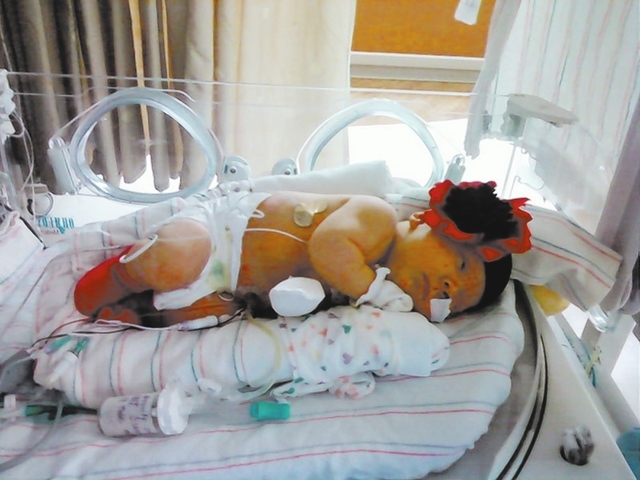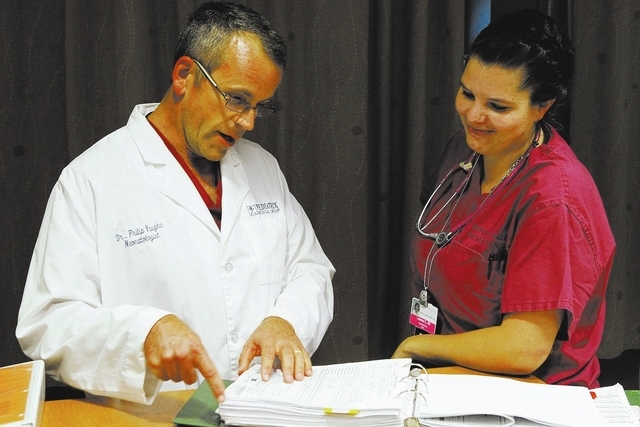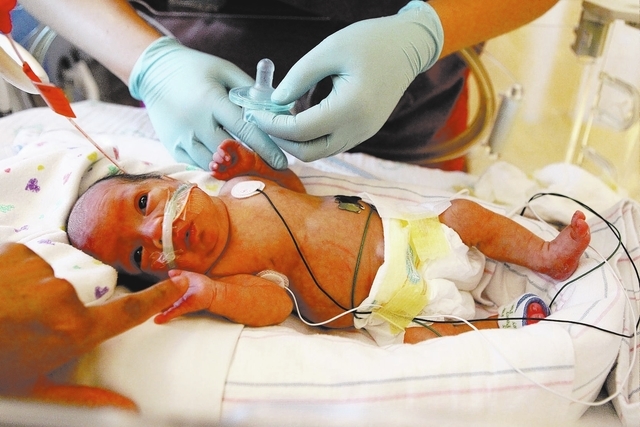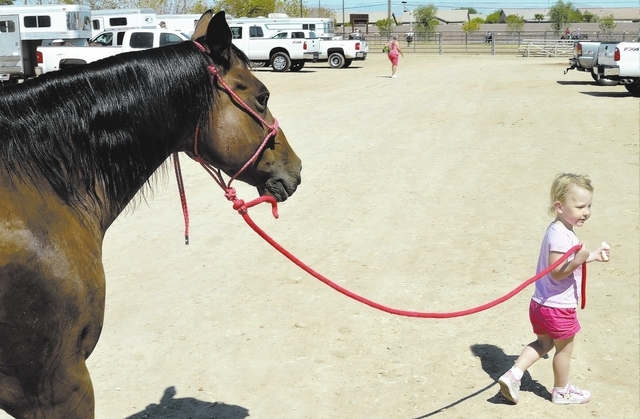Saved child’s parents hold rodeo event to benefit hospital staff
Necrotizing enterocolitis.
Marla Stevens, a training officer with the Metropolitan Police Department, had never heard of it. Neither had her husband, Patrick, a security specialist at the Nevada National Security Site.
But now, four days after Marla had given birth at Spring Valley Hospital, they were told their infant daughter, Bailey Rae Stevens, would probably die from the gastrointestinal disease, a rare condition affecting only 1 in 2,000 to 4,000 births and one that continues to confound the best medical minds.
July 12, 2010.
Not surprisingly, what the doctor told them on that date — “you better kiss her goodbye” — is seared into the memories of the first-time parents, the kind of memories that still can wake them up in a cold sweat.
It’s also not surprising that they will never forget the signs of progress along the way to their daughter’s miraculous recovery, one that has seen a baby girl go from a ventilator and a body full of IVs to the back of a brown-and-white paint horse named Hollywood. On a recent day, the giggling toddler sat tall in the saddle, frequently squealing with delight as her parents led her on a gentle ride through Horseman’s Park in east Las Vegas.
What is surprising about how the Pahrump couple reacted to their daughter’s brush with death, however, is their method of saying “thank you” to the medical staff who work in the Spring Valley Neonatal Intensive Care Unit, or NICU, where Bailey spent nearly the first four months of her life. Nurse practitioner Kelly Wagner Kaiser said she’s never seen anything like it. Neither has Dr. Phil Vaughn nor nurse Lindsay Goss.
The Stevenses organized the “Buckles and Barrels for Bailey” barrel race, a rodeo event now in its third year at the South Point Arena and Equestrian Center in which a horse and rider try to complete a clover-leaf pattern around preset barrels in the fastest time. All event proceeds — more than $22,000 was raised in the first two years — go to benefit educational opportunities for members of the Spring Valley Hospital NICU.
The three-day annual affair draws as many as 300 riders and their families from Nevada, Arizona, New Mexico, California and Colorado. This year’s event winds up about 3 p.m. today after a 7:30 a.m. start and can be seen for free.
“I’ve never had a family go tosuch great lengths to show their appreciation,” said Wagner Kaiser, who oversaw much of Bailey’s care at Spring Valley, but who recently took a position at University Medical Center. “I can’t tell you how good it makes the team feel. The money they donate is one thing. But we’re talking about people dealing with all kinds of roadblocks to make something happen.
“The time they put in every year is incredible. They organize volunteers, there’s been insurance and tax issues. They’re so tenacious. When they believe in something, they won’t take no for an answer.”
On a day off recently from training officers on the correct use of force, Marla Stevens was doing what she and Patrick are always doing this time of year: making sure volunteers are ready to help unload horses from trailers; keeping the website she and Patrick designed together, www.bucklesandbarrels4bailey.com, up to date with the latest rules and event times; thanking sponsors for their participation; getting information out via Twitter and Facebook; planning lunches and a dinner for the volunteers, making sure prizes of both money and buckles are ready for contestants.
“I’m always exhausted this time of the year,” she said.
But she hastens to add it is a good exhaustion.
“We’re so blessed and thank God every day for the gift of Bailey and the medical staff that helped her recover,” she said. “I realize it’s their job to help babies, but how do you thank someone for saving your baby’s life and making a difficult time bearable. Saying ‘thank you’ just didn’t seem enough.
“My husband and I had put on small barrel races before — we’re a family that just loves horses,” she added. “And we thought we could put on something involving horses that would raise money to help the staff save more babies. ”
What was initially just a dream, she said, started to become a reality after she wrote a letter explaining what had happened at Spring Valley Hospital to Michael and Paula Gaughan, owners of South Point.
After she and Patrick were asked to meet with the Gaughans, Marla Stevens said the couple long known for playing a key role in the entertainment industry in Las Vegas made the use of their equestrian facility affordable.
That piece of the dream seemingly doable, the Stevenses soon found they had to find a way to navigate giving money to a hospital that is part of the for-profit Universal Health Services system. It turned out that the hospital auxiliary had nonprofit status and could use donated money for educational training.
It was, of course, what the Stevenses wanted.
“I’m told the nurses already were able to have extra training that they wouldn’t have been able to have without our donations,” Patrick Stevens said, pointing out that he and his wife must approve how the donated money is used.
They also wish that some of the money they raise could help to one day find a better way to deal with necrotizing enterocolitis, which medical professionals call NEC for short. That message, which they deliver to friends, family and acquaintances with an evangelistic zeal, has helped them attract volunteers to help run the barrel race.
“Bailey had a very severe form of NEC,” noted Dr. Phil Vaughn, one of the neonatologists who cared for the baby. “Most children with it don’t require surgery. They can be dealt with medically with antibiotics and by stopping their feeding for a while. While we don’t know the cause of the disease, we do know it mainly strikes premature children.”
Bailey Rae Stevens was born five-and-a-half weeks early. Marla Stevens, who said she had largely experienced an “easy” pregnancy, was at a baby shower when her water broke. At first, doctors thought her child would be fine, especially because Bailey weighed more than 5 pounds and her lungs were working well, not the usual situation with premature babies.
But when Bailey was 4 days old, Marla Stevens received the phone call from the hospital that turned her life upside down: She was told Bailey was on three antibiotics because of something called NEC that was eating away at her intestines.
“I couldn’t believe it,” Marla Stevens said. “I didn’t understand how it could happen.”
Though NEC’s exact cause is unknown, some researchers theorize that the intestinal tissues of premature infants are weakened by too little oxygen or blood flow. That means that when feedings are started, the added stress of food moving through the intestine allows bacteria generally found in the intestine to invade and damage the wall of the intestinal tissues. While the disease usually affects only a short segment of the intestine, it can progress quickly, as it did in Bailey’s case, to involve a much larger portion.
Theoretical discussions about why their child contracted NEC were not what Patrick and Marla Stevens were having on the night of July 12, 2010, however.
As surgeon Kelly Kogut prepared to remove what turned out to be 70 percent of Bailey’s small intestine — the tissue was dead — the couple remember her telling them, “You better kiss her goodbye.”
“I will never forget the moment that I leaned in to kiss Bailey before surgery because she grabbed my finger and wouldn’t let go,” Marla Stevens said. “I thought she was saying goodbye but it turns out she was showing me how strong a little girl can be.”
Eleven minutes after she started the surgery, Kogut was done.
“There’s no question her surgical skill had a lot to do with Bailey living,” Marla Stevens said.
If their baby survived, Kogut said, other surgeries, including one sewing the healthy areas of intestines back together, would be required. During the next 108 days, Bailey lived because of ventilators, IVs carrying nutrition and medication, and the medical staff’s attention to detail.
The Stevenses are also convinced that the love of the staff for their baby also had a lot to do with it, that all the constant medical chores, including frequent suctioning of their baby, making sure the vital signs were on track, constant weighing of the diaper to make sure the little one was voiding, wasn’t enough by itself.
“I came in there one night and nurse Jeff Smith was singing over and over again, ‘How’s my little princess, I love you, Bailey.’ It was then that I realized how lucky I was to have Bailey there. Those nurses are a different breed. Bailey still recognizes his voice today and jumps in his arms when she hears it.”
The Stevenses were also moved by how nurse Kristy Spilotro bought Bailey pink sheets and a pink blanket, how nurse Lindsay Goss crocheted a purple blanket for her and made her big flowered headbands. They also noticed how the staff always talked to her, carrying her when they could, making sure she had the human touch.
The Stevenses greatly appreciated how nurses talked doctors into letting them hold their baby free of wires and tubes for an hour a day.
Nurses were just as impressed with the security specialist and the cop who came in day after day.
“Marla always remembered to take her gunbelt off,” nurse Goss said, laughing.
When she couldn’t hold her child, Marla Stevens appreciated the way nurses talked with her.
“That helped me so much when I was worried,” Marla Stevens said.
Nurse Goss remembers that the staff worried about both of the Stevenses, who were doing their jobs and still driving home to Pahrump to catch a few hours sleep.
“They became part of our family,” the nurse said. “That’s a long drive.”
Goss recalls Stevens telling her how she had tried to help so many abused children in her police work, how she wondered why her baby ended up fighting for her life.
“I told her that her work made her the perfect parent for Bailey, that she knew how to give her the tender love she needed,” the nurse said.
The discussions between nurse practitioner Kelly Wagner Kaiser and Marla Stevens covered their whole lives, they said. Wagner Kaiser told the worried mother how she once lost one of her own children.
The pair became so close that Stevens was the maid of honor at Wagner Kaiser’s recent wedding.
Finally, after nearly four months in the hospital — Bailey’s intestines were reattached — the little girl was ready to go home. But she still needed a feeding tube. To ensure their daughter didn’t acquire an infection from them, the Stevenses dressed like doctors at home, gowned and with gloves.
Marla Stevens’ fellow police officers, moved by her predicament, donated six months of vacation time to the woman who had used all of hers. That time off, she is convinced, allowed her to give Bailey the love and care she needed to grow strong enough to get rid of her feeding tube in 2011.
“She got off it so much faster than doctors thought, ” Stevens said.
Today, Bailey seems like virtually any other child. There are some things she can’t eat, fake sugar and carbonated water among them.
“I think she’s always going to be tall and slim and not be able to eat certain things,” said Marla Stevens, who stands 5 feet 10 inches tall herself. “That’s a far cry from what we thought was going to happen. And Patrick and I believe the love she felt from the Spring Valley NICU had a lot to do with that.”
Paul Harasim is the medical reporter for the Las Vegas Review-Journal. He can be reached at pharasim@reviewjournal.com or 702-387-2908.

























